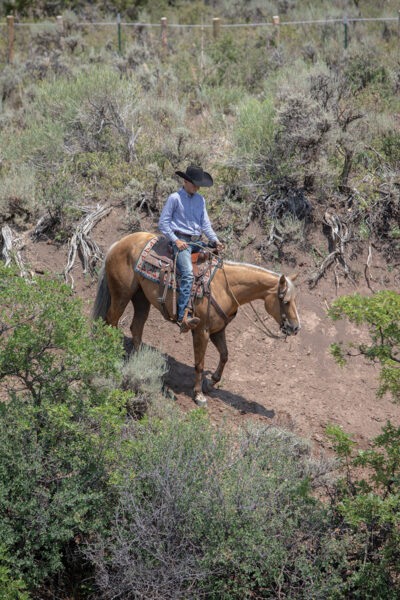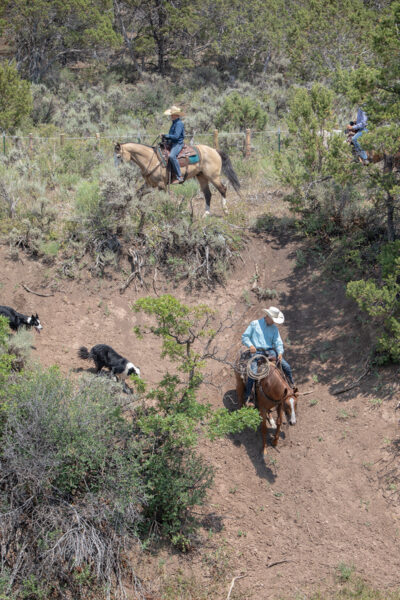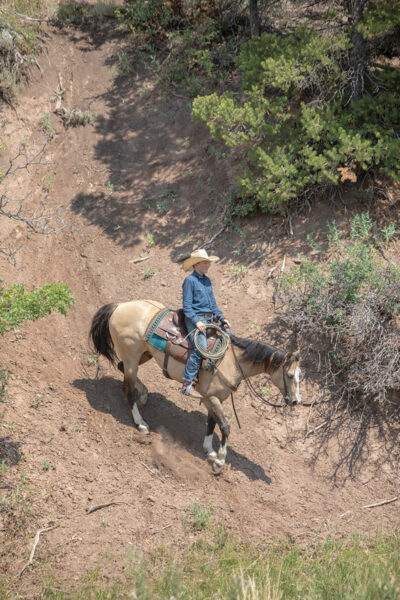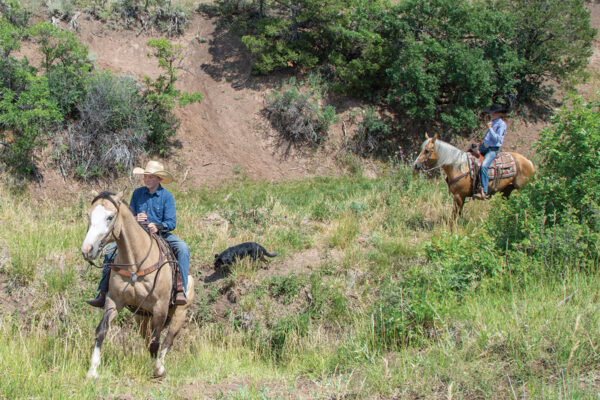Ready to ride out of the arena and on a trail with sloping hills or dramatic angles? You’ll need to know how to position yourself for optimum balance—and how to keep your horse calm and thinking about his every step. Follow these tips for safely riding your horse up and down hills.

When traveling uphill or downhill, you’ll keep your posture in the same position as if you were hiking up or down. You want to be parallel to the trees. If you lean too far back or forward, you can change your horse’s center of balance and make it harder for him to carry you.
You’ll also need to think about your horse’s needs. If your horse is worried about the change in terrain, it’s best to ride with someone you trust in front of you and behind you so that your horse will feel confident and know he can’t turn back.
Here, 14-year-old Colter Ralston (riding a buckskin) and 16-year-old Parker Ralston (on the palomino) show how they ride up and down the steep terrain on their Colorado ranch. Their dad, Aaron Ralston, helps coach the brothers for ranch riding and cow-work events.
Riding Your Horse Down Hills
Think about your horse before you head down a steep slope. If he is young or inexperienced, it’s best to have an experienced horse and rider lead the way. The experienced horse will help pick the best route and show the other horses where to go and how to travel.

You may also want to ask a third rider to ride behind an inexperienced horse to block the way if your horse would rather turn back. If a worried horse only has a horse behind him, he may choose to return to his buddy instead of continuing the downward trek.
When you’re riding down, allow your horse to pick his path and maneuver carefully, as long as he is being patient and trustworthy. If your horse is nervous, you may need to steer him toward the safest path or in the direction that the lead horse chose.
Move your reining hand down to your horse’s neck to allow him to see where he’s going. Make sure you can pick up your reining hand for contact if needed. Riding with one hand, push your free hand down on the saddle horn.
Keep your shoulders up and back—but not leaning back on the horse’s hindquarters or touching the back of the saddle. Again, think of keeping your body parallel to the trees.

“Make sure you are standing straight up between the earth and the sun,” Aaron says. He adds that you should keep weight in your stirrups and your heels down.
Go Slow
When a truck drives down a mountain pass, the driver uses a low gear to keep the truck moving slowly instead of riding the brakes. Imagine your horse moving in a slow gear as he travels downhill, too. You may need to slowly and gently pull up with your reining hand occasionally to apply the brakes. If necessary, ask your horse to stop and start again.
“If your horse starts to build speed, then his balance is much harder to control,” Aaron says.
While it may be tempting for your horse to trot or speed up once he sees the end of the hill, keep him slow. Picking his way along slowly will help him know where his hooves are placed and help him to build muscle, too.
Keep Your Distance
Make sure not to ride too close to the horse in front of you. The lead horse will need to find his way down and have time to pick the best path without rushing. Keep at least a horse-length in between horses just in case a horse takes a misstep. Plus, you don’t want to pile up at the bottom or the top of a hill. Make sure there’s somewhere safe to stop to as you wait for others to finish the path.
Aaron also recommends avoiding any narrow and steep paths. He says horses need space to widen their back legs as they lean back to balance. If you ride through two big rocks or bushes, your horse may not be able to widen his stance to balance.
“Voice your concerns to your trail mates and let them know what feels safe for you,” he says.
Riding Your Horse Up Hills
The skills you learn when going down apply when moving up a steep hill, too. Make sure to keep the horses spaced out and follow an experienced horse when possible.
To go up, your position changes to help your center of gravity. You’ll need to lean slightly forward, keeping the body position you would have if you were hiking up. Hold the saddle horn with your free hand and pull. Place your reining hand in front of the saddle, low and pointed in the direction you want to go: up. Make sure to keep weight in your stirrups and your heels down.

Aaron says horses often want to trot or lope when going uphill. Moving faster helps them gain momentum. However, it’s best to take one step at a time to make sure your horse doesn’t slip; this also helps him build up his hindquarter muscles.
Stay Straight
When you’re going up, be careful not to allow your horse to turn sideways. Horses that aren’t confident may choose to go back down to meet their buddy horses. Turning sideways doesn’t allow your horse to balance, and it’s easy for horses to slide in this position.
Keep your reining hand pointed uphill and correct your horse if he moves his nose away from your uphill direction. Don’t wait for him to turn a hoof sideways. If he does turn to the side, use your position to counter-balance him. Lean toward the steep side of the hill, and don’t add weight to the low side. It may be the safest option to return to the bottom of the hill and start again.
If you keep your horse in the correct herd position and moving slow, you’ll move up and down with ease and teach your horse to pick the best path.
Meet the Trainer
Aaron Ralston works his horses on his family’s Collbran, Colo., cattle ranch and prepares them for world-class competition. He won Top 10 honors at the 2021 AQHA Versatility Ranch Horse World Show and has championship titles in reining, cutting, working cowhorse, and calf roping. He earned gold for the United States reining team at the 2006 FEI World Equestrian Games.
This article about riding your horse up and down hills appeared in the September/October 2022 issue of Young Rider magazine. Click here to subscribe!


